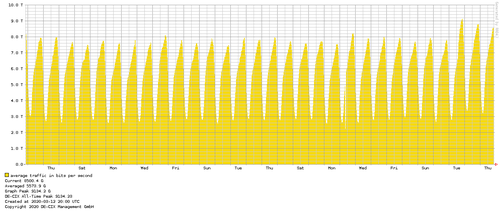Fortnite, Netflix, Call of Duty, videoconferencing and other online services are growing in popularity amid the new coronavirus outbreak. Are network operators ready for a digital deluge?

As COVID-19 spreads across the world, network operators are in the early stages of preparing for what could be a record-setting digital deluge.
In the US, Verizon announced Thursday it would increase spending on its network this year by roughly $500 million, partly in response to the new coronavirus. The operator said it now expects to allocate $17.5-$18.5 billion on capital expenses in 2020, up from its previous guidance of $17-$18 billion. "This effort will accelerate Verizon's transition to 5G and help support the economy during this period of disruption," the operator said in a release.
"We're looking towards the future and increasing our investments so that we're poised to offer even more robust networks, to meet future demands, in the years to come," Verizon CEO Hans Vestberg said in a statement. "We are very confident in our company's ability to meet current demands in providing a great network experience."
Verizon said it has not yet seen a "measurable increase in data usage" due to Americans increasingly staying home over coronavirus concerns.
It may only be a matter of time before that changes.
Record traffic figures
Some of the world's biggest Internet interconnection hubs – which help route traffic from one provider to another – are reporting record traffic numbers. For example, DE-CIX in Frankfurt is one of the world's busiest Internet interconnection hubs, and this week it reported a new all-time traffic peak of more than 9.1 Tbits/s.
Figure 1:  DE-CIX reported record traffic figures this week.
DE-CIX reported record traffic figures this week.
(Source: DE-CIX)
"Whether it's for exchanging information, streaming films, playing online games, or the exceptional situation people are currently experiencing with the COVID-19 virus, Internet usage is playing an ever-greater role," said Thomas King, DE-CIX's CTO, in a statement. "Guaranteeing a stable and secure Internet infrastructure – regardless of how challenging the times are – is one of our highest priorities."
DE-CIX isn't the only European Internet exchange to record spikes in traffic. As noted by Amazon AWS engineer Giorgio Bonfiglio on Twitter, the exchanges in London, Amsterdam and Milan are also seeing traffic increases.
Internet, what's going on? Some European IXPs are reaching their all-time peak right now.
— Giorgio Bonfiglio (@g_bonfiglio) March 10, 2020
DECIX (9T), LINX (4.5T), AMS-IX (7.8T), MIX (1T!) pic.twitter.com/mmezaGFLSB
Moreover, some exchanges in the US are beginning to record similar trends.
"We are seeing a sustained 20% more B2C [business-to-consumer] and B2B [business-to-business] traffic over the past few days," said Dave Temkin, co-founder of Internet connectivity organization Community IX, of the group's Internet exchange in Florida. "This is indicating a high number of people working from home and staying home when they're done."
Similar rises in network traffic can be seen in an Internet connection hub in Seattle that is also connected to Community IX. Seattle was one of the first US cities to see COVID-19 outbreaks.
Figure 2:  The SIX Internet exchange in Seattle is showing rising traffic levels.
The SIX Internet exchange in Seattle is showing rising traffic levels.
(Source: SIX)
A variety of traffic sources
"We reported an increase of more than 70% of Internet traffic over our landline network, with a big contribution from online gaming such as Fortnite," said Luigi Gubitosi, CEO of Italy's Telecom Italia, on Wednesday, according to a Bloomberg article.
The Italian government has mostly banned public travel – and has taken the extraordinary step of closing most nonessential stores – in an effort to stem the spread of the coronavirus. The situation is pushing schoolchildren onto Fortnite and adults into their home offices.
"All the big players in the video conferencing market have asked for bandwidth upgrades in the last 10 days," Telia Carrier VP Mattias Fridström told Bloomberg. The operator, a wholesale telecom operator based in Sweden, reported that traffic on its network grew 2.7% in February.
Of course, rising Internet traffic can be due to a wide range of factors. For example, Community IX's Temkin pointed out that video game company Activision recently released the popular free-to-use video game "Call of Duty: Warzone," which requires a massive 100GB download to play.
"We continually evaluate peak data usage times and build our networks to stay ahead of that demand," said Verizon's top networking chief, Kyle Malady, in a statement. "While we may see the hours where data usage shifts from evening to daytime, our network peak is built to manage evolving demands. While it is not clear yet how having millions of additional people working from home will impact usage patterns, we are ready to address changes in demand, if needed."
Telecom's workforce heads home
While they're dealing with record-setting levels of traffic, some of the world's telecom operators are doing so with a partially homebound workforce. Like many US companies, Verizon this week notified employees who are able to work remotely that they have that choice. "We continue to serve our customers and our facilities remain open to maintain uninterrupted service for our customers," the operator noted of its response to COVID-19.
Similarly, an AT&T representative said the operator also is encouraging employees in highly affected areas to work from home. "Our offices remain open for employees who need or want to work onsite," the company said of its own precautions.
Of course, some telecom workers are unable to work from home. As reported by Wireless Estimator, a publication that carefully tracks the US cell tower industry, tower technicians often have to venture outdoors – and to hotels and restaurants – to conduct the physical work necessary to upgrade wireless transmission equipment.
— Mike Dano, Editorial Director, 5G & Mobile Strategies, Light Reading | @mikeddano
About the Author(s)
You May Also Like











